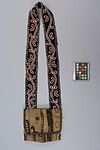gwēł (Bag)
About this object
History of use
The strip of Chilkat weaving that forms the pouch would have represented the prestige of such a gift, distributed ceremonially to significant persons by a chief with so much wealth that he could afford to cut up this most valuable regalia: a Chilkat robe twined of mountain-goat wool by an expert and high-ranking Tsimshian or Tlingit weaver. The Tahltan-style strap was likely newly made before being sewn onto the back of the pouch; it is embellished with an appliquéd wool-fabric pattern of red plant motifs on a black background, outlined with white glass beads. The pouch is folded in such a way that a profile face is featured on the front flap; that face and the forms extending from it reveal that this piece of weaving was cut from the centre-left portion of a fine, old Chilkat blanket. Such profile faces often represent part of the body of the main creature abstractly depicted on these robes of nobility. Who might have worn this bag is no longer known, yet it surely hung as both finery and history from its owner’s shoulder.
Narrative
Featured in the exhibition, "Mehodihi: Well-Known Traditions of Tahltan People", a collaborative exhibition mounted by the Tahltan Nation and the Museum of Anthropology in 2003.
Physical description
Bag made from a cut-out piece of a handwoven Chilkat robe, in black and very faded yellow, edged with red twine, black fabric and white beads; the flap holds half of a Chilkat ancestor face. The separately sewn Tahltan-style strap is embellished with an appliquéd wool-fabric pattern of red plant motifs on a black background, outlined with white glass beads. The pouch is folded so that the profile face is featured on the front flap; that face and the forms extending from it reveal that this piece of weaving was cut from the centre-left portion of a fine, old Chilkat blanket. The strap is attached at the back of the pouch.
Categories
